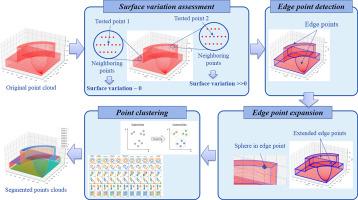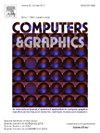基于表面变化分析和HDBSCAN聚类的自动交互式点云分割的综合混合方法
IF 2.8
4区 计算机科学
Q2 COMPUTER SCIENCE, SOFTWARE ENGINEERING
引用次数: 0
摘要
分割是逆向工程和计量学中处理点云的四种主要操作之一。存在许多分割方法,包括区域增长、属性聚类、边缘检测和基于机器学习的方法,每种方法都有自己的优缺点。将这些方法结合起来的混合方法通常可以产生更好的结果。本文提出了一种基于表面变化分析和聚类技术的机械零件三维点云分割的四步混合方法。该方法首先评估表面变化参数以区分边缘和非边缘点,然后基于阈值的边缘点分离。然后引入边缘点扩展技术,通过增强边缘点与表面点之间的空间区别来改善分割结果,从而降低聚类算法的灵敏度。最后,采用HDBSCAN聚类方法将剩余的点分成不同的簇,代表单个表面。通过对机械零件合成点云的实验验证了该技术的有效性,其中包含了附加噪声和密度变化。实验验证了该方法在机械部件逆向工程中的鲁棒性。最后以测点云为例,验证了该方法的可行性。还开发了交互式图形用户界面(GUI),以便在分割过程中进行实时调整。这项研究为自动3D点云分析做出了重大贡献,并支持了工业4.0的进步。本文章由计算机程序翻译,如有差异,请以英文原文为准。

A comprehensive and hybrid approach to automatic and interactive point cloud segmentation using surface variation analysis and HDBSCAN clustering
Segmentation is one of the four main operations involved in processing point clouds for reverse engineering and metrology. Numerous segmentation methods exist, including region growing, attribute clustering, edge detection, and machine learning-based approaches, each with its own strengths and weaknesses. Hybrid approaches, which combine these methods, can often yield improved results. This paper proposes a novel, hybrid, four-step method for segmenting 3D point clouds of mechanical parts, based on surface variation analysis and a clustering technique. The method begins with the evaluation of a surface variation parameter to differentiate edge and non-edge points, followed by threshold-based separation of the edge points. An edge point expansion technique is then introduced to improve segmentation results by enhancing the spatial distinction between edge and surface points, thereby minimizing the sensitivity of the clustering algorithm. Finally, the HDBSCAN clustering method is employed to group the remaining points into distinct clusters representing individual surfaces. The effectiveness of the proposed technique is validated through experiments on synthetic point clouds of mechanical parts, incorporating added noise and density variations. These experiments demonstrate the method's robustness in reverse engineering applications for mechanical components. A measured point cloud is also taken as an example to verify the feasibility of the proposed method. An interactive graphical user interface (GUI) is also developed to facilitate real-time adjustments during the segmentation process. This research significantly contributes to automatic 3D point cloud analysis and supports advancements in Industry 4.0.
求助全文
通过发布文献求助,成功后即可免费获取论文全文。
去求助
来源期刊

Computers & Graphics-Uk
工程技术-计算机:软件工程
CiteScore
5.30
自引率
12.00%
发文量
173
审稿时长
38 days
期刊介绍:
Computers & Graphics is dedicated to disseminate information on research and applications of computer graphics (CG) techniques. The journal encourages articles on:
1. Research and applications of interactive computer graphics. We are particularly interested in novel interaction techniques and applications of CG to problem domains.
2. State-of-the-art papers on late-breaking, cutting-edge research on CG.
3. Information on innovative uses of graphics principles and technologies.
4. Tutorial papers on both teaching CG principles and innovative uses of CG in education.
 求助内容:
求助内容: 应助结果提醒方式:
应助结果提醒方式:


